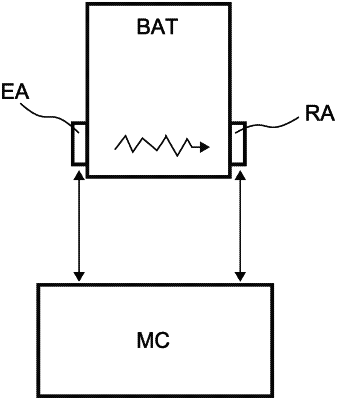| CPC H01M 10/4257 (2013.01) [G01N 29/07 (2013.01); H01M 10/48 (2013.01); G01N 2291/011 (2013.01); H01M 2010/4271 (2013.01)] | 9 Claims |

|
1. A method for detecting an anomaly in the operation of a battery using a battery management system, said system comprising an acoustic emitter configured to be attached to a wall of the battery, an acoustic receiver configured to be attached to a wall of the battery, said acoustic receiver being attached to a wall of the battery during the implementation of the method, and a calculating system connected to the acoustic emitter and to the acoustic receiver, a mapping defining a first operating region corresponding to a normal operating region, a second operating region corresponding to an at-risk operating region and a third operating region corresponding to a dangerous operating region, wherein the mapping comprises a reference point located in the normal operating region, each region being associated with a speed limit, a speed being positive when the speed is moving away from the reference point and negative when the speed is approaching the reference point, said method comprising at least a first measurement cycle, each measurement cycle being separated from the preceding measurement cycle by a period termed the measurement period, each measurement cycle comprising:
a step of emitting an acoustic signal by the acoustic emitter on instruction from the calculating system;
a step of receiving an acoustic signal by the acoustic receiver, the received signal being transmitted to the calculating system so as to obtain a measurement point in the mapping;
a step of determining the operating region in which the measurement point is located;
a step of calculating the speed of the measurement point in the mapping, said speed being equal to the distance between the measurement point obtained during the preceding measurement cycle and the current measurement point divided by the measurement period;
a step of comparing the speed of the measurement point with the speed limit associated with the operating region in which the measurement point is located;
when the measurement point is located in the at-risk operating region or in the dangerous operating region, and when the speed of the measurement point is greater than the speed limit associated with the operating region in which the second measurement point is located, triggering the step of detecting an anomaly.
|